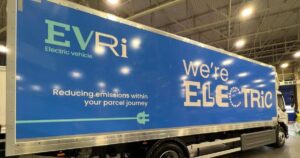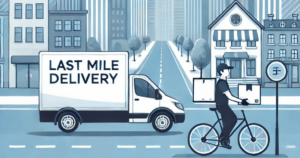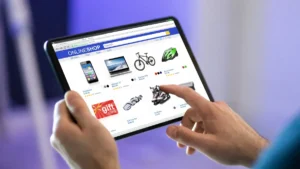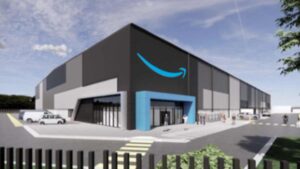Last mile delivery costs retailers a fortune, and the race is on to get technology to make this part of the logistics process cheaper.
Since the start of the COVID-19 pandemic, there has been a boost in online shopping and home deliveries. This growth never really subsided; instead, it just kept growing.
The only thing that really changed is: Customers are now demanding faster deliveries, while they also don’t want to pay an arm and a leg for the service.
That leaves retailers and small businesses in a tight spot. To stay competitive and make sure customers don’t go to a competitor, entrepreneurs need to come up with clever ways to reduce last-mile delivery costs.
In this article, we’ll examine what drives last-mile delivery costs and the hidden costs, as well as how to identify the challenges and devise new ways to make it more affordable.
The cost of last mile delivery
On average, the last-mile delivery accounts for roughly half of the supply chain cost. Many elements contribute to this large bill.
Think of the delivery drivers who need to earn a salary for taking the parcel to the customer’s front door. Remember, the driver needs a vehicle that has to be maintained and serviced regularly. That’s part of the last mile delivery costs.
The vehicle requires fuel to drive around and complete that last mile delivery. But let’s not forget about live communication with the customer to inform them when the parcel is at the garage.

When customers are not happy with their order and wish to return it, the process gets repeated, and often, the last mile delivery costs fall squarely on the business.
The rise in customers’ demands for sustainable deliveries and artificial intelligence-driven supply chain technology is also impacting the costs of the final mile.
Hidden costs of failed deliveries
No one really talks about the last mile delivery costs involved in failed or missed deliveries. But it’s, in fact, an expensive financial burden.
Here are the implications:
Extra fuel: Yes! You never planned for a delivery to be missed; you try to get it right the first time (we hope). But if a customer is not at the given address at the time of delivery, it could mean the driver has to turn back and spend more money on making the same trip for a second time.
Wasted labor hours: Although the delivery was unsuccessful, it doesn’t mean the delivery driver should not be paid for the work. It’s time spent on the road when a driver could have delivered other parcels successfully.

Customer satisfaction: In extreme cases, a missed delivery can frustrate a customer and make them negative toward the brand. This could have a ripple effect on the business in the future.
With technology like real-time tracking, modern businesses can drastically reduce failed deliveries with accurate tracking software. Last-mile delivery optimization helps improve customer satisfaction.
How to use software to cut final mile delivery costs
Using data and predictive analytics can help a business forecast delivery times, optimize delivery routes, and cut down on unnecessary expenses. It also helps steer you in the right direction where cuts can be made to stop wasteful expenditure.
How do you do it? Optimize your delivery routes.
By optimizing your delivery routes with delivery management software like Locate2u, you have all the solutions in one place.
It uses real-time traffic and weather data to build the most efficient delivery routes. This helps reduce fuel costs and travel time and increases the ETA.
Want to know how live package tracking works? Read more here: 14 Things You Need To Know About Live Package Tracking.
Delivery software management encourages customers to give feedback and rate their driver’s performance. This feedback helps identify areas within your fleet that need improvement.

How to increase delivery density to cut last mile costs
The more deliveries a van or truck can make in a smaller area, the lower the cost per delivery. According to Medium, increasing route density can limit the driver’s time on the road.
Adding more stops in a given area increases the number of deliveries per hour. This can significantly lower the delivery cost.
However, this is not the same for a rural area where a driver would take longer to make one or two stops due to the location.
When it comes to food delivery service, Locate2u CEO Steve Orenstein says most companies don’t understand the fundamentals of delivery density.
“[It’s] really challenging because the driver can pick up a maximum of two to three parcels in one go.” But the food turns cold if the delivery driver tries to add more deliveries to the trip. However, frozen meals make a lot more sense.

Micro warehousing is a relatively new concept in last mile deliveries. This allows for small warehouses closer to residential areas to ensure faster deliveries near customer locations.
Impact of same day delivery on profit margins
Here’s a controversial question: Should businesses pass on the last mile delivery costs to the customer?
Many studies have been done to find the answer to this burning question. One such study by IWSR found that speed is vital for millennials, and they are willing to pay more for the service.
According to the Australia Post, 29% of shoppers expect their deliveries to arrive faster than they did before the COVID-19 pandemic.
This new trend, “instant gratification,” has resulted in customers demanding faster deliveries within the same day.

But who should pay? Well, Australian youth are willing to pay for the service. 79% of consumers said they’d pay up to an extra $5 to get an item they really need delivered the next day.
According to a McKinsey & Co. study, same-day delivery costs charged to consumers range from $5 to $20 per shipment. “But the willingness to pay such high prices is limited,” the report states. It warns that customers are used to subsidizing total shipping costs and are reluctant to pay extra for it.
Can green logistics save you money during the delivery process?
Going green for last-mile delivery with e-bikes, drones, or robots saves time on the road, money, and the environment. The cost of last-mile delivery is pushing startups to think creatively to cut costs and save the environment.
According to a study by Reset, it’s projected that an estimated 13.5 million e-bikes will be sold by 2030.
Electronic bikes are cheaper to maintain without the need to refuel. Compared to traditional delivery vehicles, e-bikes can save a business a lot of money in the long run. According to the American Automobile Association, maintaining delivery vehicles can cost up to $1,186 per car, while e-bike owners pay only $754 per year.
Drone delivery might sound like a better option, but it’s not yet where it can compare to the traditional delivery process. Delivering a single package by drone costs $13.50, and with a van, it’s about $1.90 a package if the van carries about 100 orders. This price could, however, significantly drop if the drone operators could have each employee monitor 20 drones at once.

Smart lockers eliminate failed deliveries during last mile
Smart lockers are taking off in Europe, especially due to their convenience. DHL says smart parcel lockers are “quietly transforming e-commerce logistics.” According to Harvard Business Review research up to 20% of e-commerce packages are failed deliveries on the first attempt.
Customers don’t have to wait for hours at home or at the office for the last mile delivery to be completed. The percentage of failed deliveries has also been cut significantly with the help of smart lockers.
It gives customers the flexibility to retrieve the parcel from the locker when it’s most convenient for them, albeit last at night or early in the morning. Customers receive a unique password, which is then used to open the space.
This concept could save a business money by avoiding failed deliveries and ensuring greater customer satisfaction.
NOW READ: 3 Challenges in last-mile delivery and how to overcome them
About the author
Mia is a multi-award-winning journalist. She has more than 14 years of experience in mainstream media. She's covered many historic moments that happened in Africa and internationally. She has a strong focus on human interest stories, to bring her readers and viewers closer to the topics at hand.












